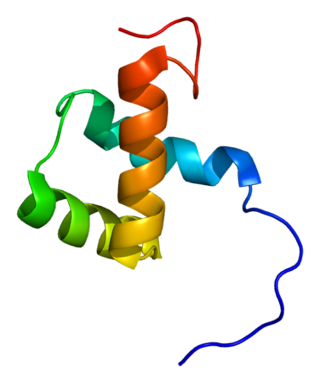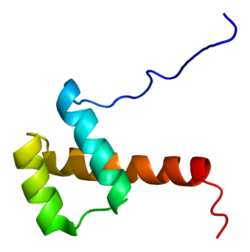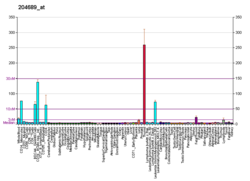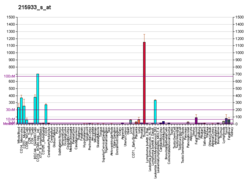
A homeobox is a DNA sequence, around 180 base pairs long, that regulates large-scale anatomical features in the early stages of embryonic development. Mutations in a homeobox may change large-scale anatomical features of the full-grown organism.

Homeobox protein NANOG(hNanog) is a transcriptional factor that helps embryonic stem cells (ESCs) maintain pluripotency by suppressing cell determination factors. hNanog is encoded in humans by the NANOG gene. Several types of cancer are associated with NANOG.

GATA2 or GATA-binding factor 2 is a transcription factor, i.e. a nuclear protein which regulates the expression of genes. It regulates many genes that are critical for the embryonic development, self-renewal, maintenance, and functionality of blood-forming, lympathic system-forming, and other tissue-forming stem cells. GATA2 is encoded by the GATA2 gene, a gene which often suffers germline and somatic mutations which lead to a wide range of familial and sporadic diseases, respectively. The gene and its product are targets for the treatment of these diseases.

Homeobox protein MSX-1, is a protein that in humans is encoded by the MSX1 gene. MSX1 transcripts are not only found in thyrotrope-derived TSH cells, but also in the TtT97 thyrotropic tumor, which is a well differentiated hyperplastic tissue that produces both TSHß- and a-subunits and is responsive to thyroid hormone. MSX1 is also expressed in highly differentiated pituitary cells which until recently was thought to be expressed exclusively during embryogenesis. There is a highly conserved structural organization of the members of the MSX family of genes and their abundant expression at sites of inductive cell–cell interactions in the embryo suggest that they have a pivotal role during early development.

NK2 homeobox 1 (NKX2-1), also known as thyroid transcription factor 1 (TTF-1), is a protein which in humans is encoded by the NKX2-1 gene.

Homeobox protein Hox-A10 is a protein that in humans is encoded by the HOXA10 gene.

Paired box gene 8, also known as PAX8, is a protein which in humans is encoded by the PAX8 gene.

Homeobox protein Nkx-2.5 is a protein that in humans is encoded by the NKX2-5 gene.

Homeobox protein Hox-B6 is a protein that in humans is encoded by the HOXB6 gene.

Zinc finger E-box-binding homeobox 1 is a protein that in humans is encoded by the ZEB1 gene.

Homeobox D10, also known as HOXD10, is a protein which in humans is encoded by the HOXD10 gene.

Homeobox protein Hox-A5 is a protein that in humans is encoded by the HOXA5 gene.

Homeobox protein Hox-B4 is a protein that in humans is encoded by the HOXB4 gene.

Insulin gene enhancer protein ISL-1 is a protein that in humans is encoded by the ISL1 gene.

Homeobox protein Hox-B1 is a protein that in humans is encoded by the HOXB1 gene.

Homeobox protein Hox-B2 is a protein that in humans is encoded by the HOXB2 gene.

Homeobox protein Hox-D4 is a protein that in humans is encoded by the HOXD4 gene.

Paired related homeobox 1 is a protein that in humans is encoded by the PRRX1 gene.

Iroquois-class homeodomain protein IRX-1, also known as Iroquois homeobox protein 1, is a protein that in humans is encoded by the IRX1 gene. All members of the Iroquois (IRO) family of proteins share two highly conserved features, encoding both a homeodomain and a characteristic IRO sequence motif. Members of this family are known to play numerous roles in early embryo patterning. IRX1 has also been shown to act as a tumor suppressor gene in several forms of cancer.
Brain-specific homeobox is a protein that in humans is encoded by the BSX gene.























